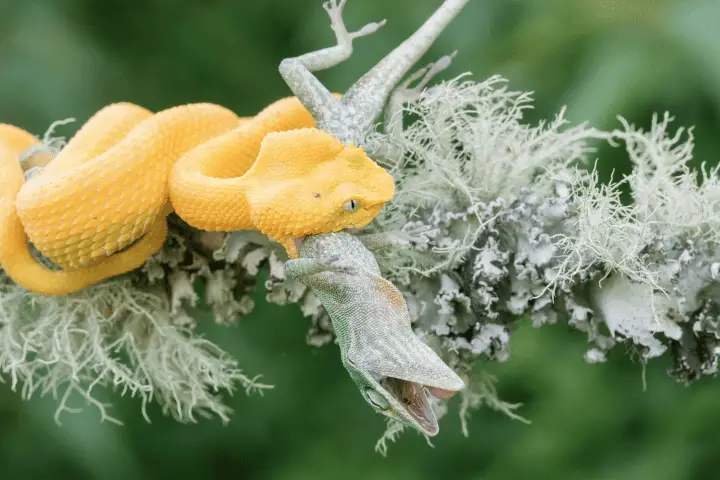Does Snakes Eat Lizards
Do snakes eat lizards?
It all depends on the species and size of the snake. Some snakes feed on rodents or insects, while others, such as the kingsnake and boa constrictor, prey on lizards.
There are many factors that can determine whether a snake will eat a lizard, including its hunting technique, camouflage ability, and other prey availability.
Snakes have impressive hunting skills, relying on ambushing or overpowering their prey.
Consuming lizards offers snakes valuable nutrients. This provides them with protein and energy to maintain their body functions and growth.
So, it’s clear snakes do indeed eat lizards!
What do snakes eat?
Snakes are fascinating creatures with a unique feeding habit. They are carnivorous predators that consume a variety of prey.
Mice, rats, rabbits, birds and their eggs, reptiles, amphibians, fish, and invertebrates make up their diverse diet.
In South America, the anaconda has an extraordinary ability to devour prey larger than itself. This is a true marvel of nature!
By discovering what snakes eat, we are able to comprehend their role in balancing ecosystems.
Their hunting skills and adaptations are truly remarkable. Even when it comes to rival species, snakes won’t pass up the opportunity for a tasty meal!
Can snakes eat lizards?
Types of lizards that snakes eat
Snakes eat various types of lizards. Green Anoles, Skinks, Geckos, Chuckwallas, Gila Monsters, and Iguanas can all become prey. Snakes use special hunting techniques based on the lizards’ anatomy and behavior.
Lizards can use strategies to avoid predation. Camouflage, swift movements, living in hard-to-reach places, and having toxic/distasteful skin secretions are all effective.
Tail autotomy and bluffing also help lizards escape snakes.
How do snakes catch and eat lizards?
Hunting techniques of snakes
Snakes use their camouflage to their advantage. They blend into their surroundings and wait for their victim to come within range.
They also rely on their sense of smell and keen eyesight to detect prey. Moreover, these reptiles can swallow animals much larger than themselves in a single swift motion.
Additionally, certain snake species have developed specialized hunting techniques. For instance, the boomslang snake has venom that causes internal bleeding, while tree-dwelling snakes use ambush tactics.
Furthermore, according to a study by Christopher Randle, some snake species use complex movements to capture prey. It’s amazing how diverse and fascinating their hunting strategies are!
Eating habits of snakes
Snakes have peculiar dining habits, distinct from other species in the animal kingdom. From their hunting strategies to how they consume their prey, these slithery creatures never fail to astound us with their remarkable feeding habits.
- Snakes are carnivorous reptiles and mainly consume small mammals, birds, amphibians, and other reptiles. The type of food they eat depends on their species, habitat, and size.
- When seeking food, snakes use different techniques such as ambush hunting or actively searching for prey. Some prefer to wait and ambush unsuspecting victims, while others actively pursue their targets.
- Once a snake catches its prey with its sharp teeth or constriction technique, it swallows it whole. Snakes have highly elastic jaws that enable them to swallow animals much bigger than their head size.
- As snakes lack chewing mechanisms like mammals, their digestive system displays remarkable modifications. Digestion in snakes can take days or even weeks due to the slow movement of food through their elongated bodies.
- After eating, snakes enter a state called “post-prandial torpor” where they become lethargic and restrict their activities till digestion is done. This conserves energy and permits them to focus solely on digesting their meal effectively.
Plus, some species of snakes have additional remarkable eating habits worth mentioning.
For example, certain snake species have particular fangs designed for injecting venom into their prey prior to consuming them.
Impact on lizard populations
Snakes and lizards have been battling for survival. Snakes eat lizards, which can affect lizard populations. This can lead to fewer lizards in an area due to them avoiding snakes.
Even with defense mechanisms, snakes still hunt lizards successfully.
The Galapagos Islands are a prime example of snake predation’s impact on lizards.
Their introduction led to the extinction of native species. This showed how far snake-lizard interactions reach.
It’s all just a snack attack for snakes.
Conclusion
Snakes are fierce predators of lizards. They can swallow them whole, thanks to their ability. Also, snakes are stealthy and use ambush tactics to catch lizards.
Their sharp teeth help to hold their prey still, so they can’t escape. A snake’s jaw is flexible enough to consume lizards bigger than its head.
Snakes are highly adaptable, so they can live where lizards are. This increases the chances of them meeting, which usually results in predation.

